Recent Articles
-
July Issue of the Digest Out Now
Jul 01, 25 01:22 AM
Hanwei Mercenary Sword Review
It is easy to overlook the Hanwei Mercenary Sword.
It is, after all, not really marketed as well as it could be - and is lumped in with a series of relatively cheap completely unhsitorical swords such as the 'Lionheart' and 'Agincourt' which are really little more than tough semi-sharpened crowbars..

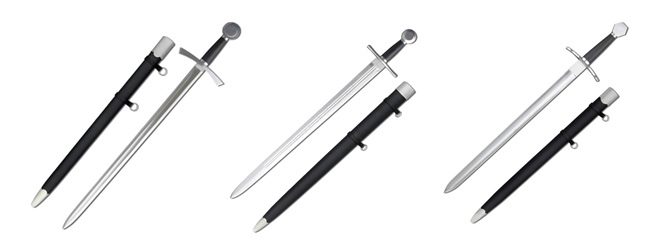 The Mercenary Swords brothers and sisters..
The Mercenary Swords brothers and sisters..But as we shall see momentarily, whether by accident or design, this is actually - at least in terms of appearance - a very good replica of a sword that was once in the personal collection of the great sword historian and scholar, Ewart Oakeshott.
But how does it stack up overall? Read on and find out!
Hanwei Mercenary Sword Review
Reviewed by David McCall, Idaho, USA
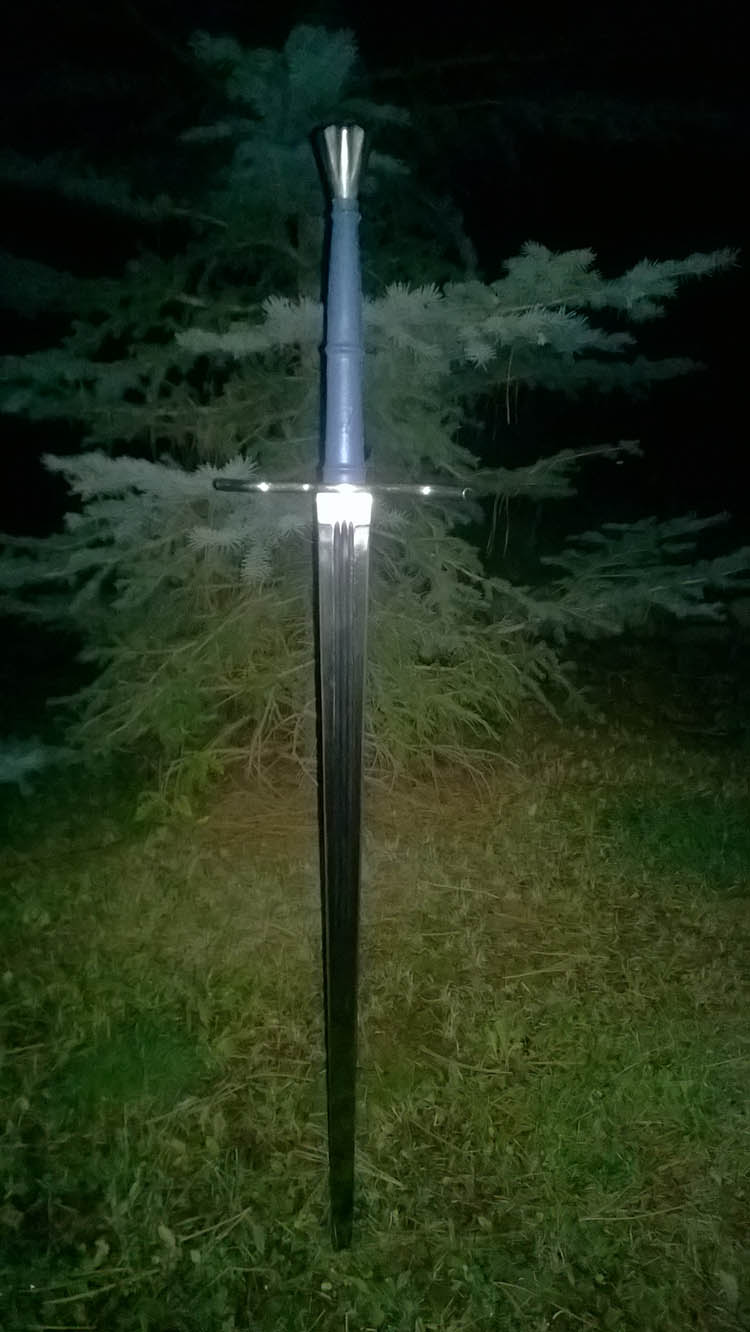
So as I said here is the start of some overdue reviews of some swords I have had for quite awhile but never got around to reviewing. This sword I’m reviewing was a special gift from a member of the community (retired SBG forum global moderator: William Swiger) and a really fun sword to use that just came back on the market. I have customized mine a bit but I feel that most will still get a feel if this sword is for them from this review.
Historical Overview
 The Oakeshott Type XX - one of the most specific categories in his typology
The Oakeshott Type XX - one of the most specific categories in his typologyThis sword easily classifies as an Oakeshott Type XX as it is a near exact replica of one formerly owned by Oakeshott himself. The Type XX were a later period sword and one of the last hurrahs for the Longsword or Warsword on the battlefield as primary weapons.
These swords were
prominently of the Warsword or Longsword categories with some single
hand variants in the sub-type XXa. The Type XX defining features
included a long two-handed grip between 8”-10” and a long triple
fullered blade tapering to an acute point. They were very imposing
battlefield weapons introduced in the late 14th century that saw
prominent use well into the 16th century.
The Type XX also had
another role in Medieval society outside the battle field. There were
even larger non-functional Type XX swords used as bearing swords for
ceremonies such as coronations and display. These swords tended to have
more rounded tips as well as decorated blades and large gaudy hilt
furniture. It could be speculated that the Type XX and its multiple uses
were both the inspiration for the more dressy XXI and XXII Typologies
as well as the large and even more imposing Zweihander and Langschwert
Greatswords of the following century.
The Type XX saw use throughout Europe but seems to be favored in Italy and England according to most archeological digs. It may have been the last of the traditional blade profiles of the middle ages but few could argue that with the Type XX the Warsword definitely went out with a bang.
Initial Impressions
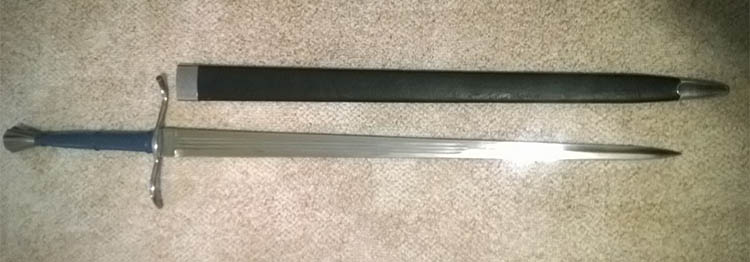
Initial impressions for this sword were probably the most fun I’ve had un-boxing a sword as to tell you the truth I didn’t know just what I was getting and William wasn’t giving any hints. The sword came in great packaging and you could tell William took some extra time when packing it. I knew what sword it was right out of the box from browsing all the seller sites. I liked the look and size and was actually quite surprised that I had acquired two Type XX swords one after the other as I had just purchased my Roven a little earlier.
Actually to tell the truth I originally thought this sword was a cheaper copy of the XVIIIc Svante Nilsson Sword. But a few of the guys set me straight about what type it was. None the less it was a welcome addition to my small collection at the time and I could happily add a Warsword to my collection. I never did get an answer from William why he chose this sword for me.
Statistics
- Blade Length: 35” (Width: 2” at base to 1/4” at the tip
- Handle Length: 9” (*Modified* 3 3/4” round at the guard to 2 3/4” at the pommel.)
- Overall Length: 47”
- Guard Width: 10”
- Point of Balance: 3 1/2”
- Center of Percussion: 20” from the guard
- Weight: A little above 4 lbs
The Blade

The blade is a pretty impressive stout piece of steel. It’s polish is of
the standard semi-gloss Hanwei is known for in their medieval swords.
The edge from what I’ve been told comes pretty dull stock and from what
William told me the edge was pretty difficult to re-profile. The steel
is pretty hard and makes me wonder just what steel it is as Hanwei’s
only description is simply “Carbon Steel”. It could be the 5160 used on
other medieval swords they offer or the 1095 they’ve said they use on
their practical katana line but more than likely it’s 1065 (Editors Note: They are actually 1566 Carbon Steel)
The
blade does have it’s “price point” faults, the most blatant being the
ugly 1” riccasso at the base of the blade. Even tough historically Type
XX were known to have riccassos, its pretty obvious that this is a
factory thing as all the “budget medievals” or as they were called back
before the re-intro, Cas Iberia models have the 1” riccasso. It would’ve
been nice (especially at the “after fire” mark ups) if they at least
removed those riccassos from the line. The fullers also stop at the
riccasso and go down to about 3/4 of the blades length. Very accurate to
the original there are three fullers following each other down the
length of the blade. The fullers are done pretty well but don’t meet up
and taper abruptly at both ends. Nothing too discerning especially at
the old price point.

Overall this blade could be classified in the modern market as a “pretty beater” with some decent attention to historical detail. The blade definitely has some extra meat to the blade though it’s still comfortable to hold and swing thanks to the high point of balance and the long grip.
The Handle
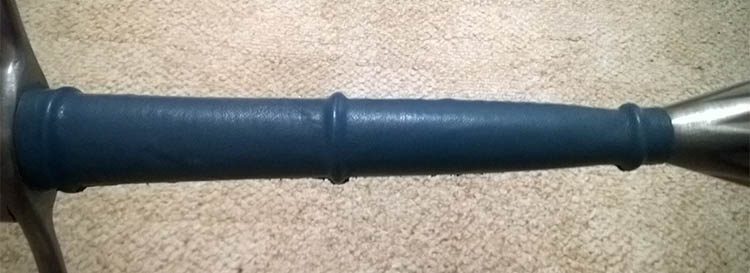
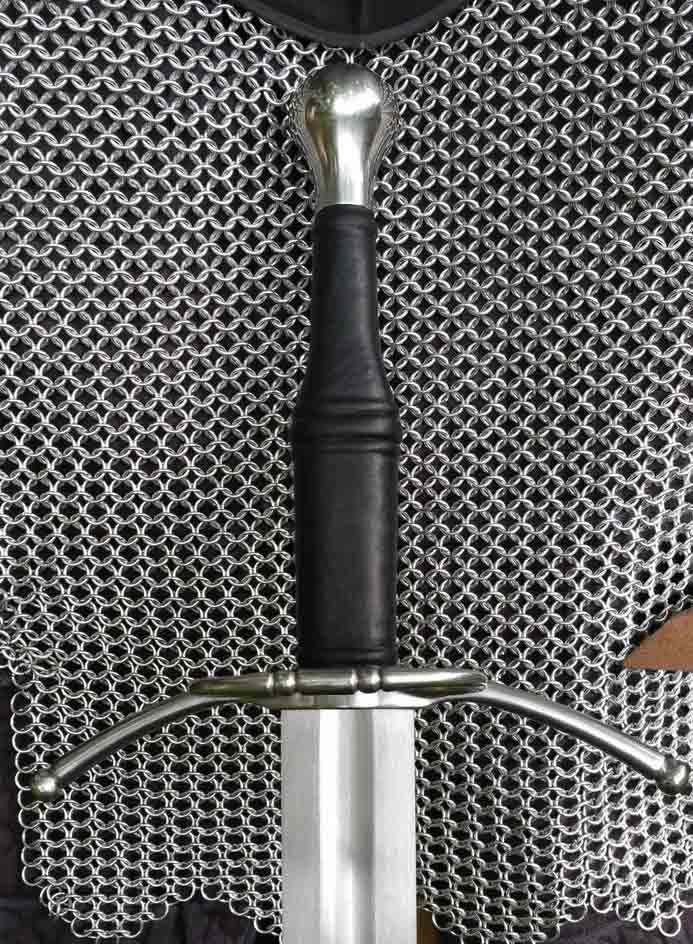
If you are curious as to some methods of how to wrap a handle like this one, click here for a tutorial
My description will be different than the stock model as I never
actually handled the stock handle as by the time I got it William had
re-wrapped it. From what I got it was cheap black leather glued to the
wood core. It seems that the original leather is the same or similar to
what’s used on the scabbard in pics. The original handle was pretty fat
and round and not very comfortable to someone smaller handed like me.
Yea I’m that guy that prefers the thin Hanwei Tinker handles. Anyway
before my handle work the grip was extra fat in the center and tapered
down from about 4” at the base to right above 3” at the pommel. It sort
of forced you to hold the sword with a spaced grip kinda like you would a
katana tsuka. It actually feels really comfortable in the swing when
gripped this way.
I decided I wanted a thinner profiled handle
with more pronounced taper, as well to suit me better. As I don’t have
any power or wood working tools I got to it with a lot of free time and
some sandpaper. I also decided to add some risers for aesthetics and
like William did with his re-wrap cover up the ringlets on both ends of
the handle. Overall I think the sword handles much better with a slimmer
handle and matches more to the original. This handle is nice and long
for added power from a spaced two-handed grip, Allowing some pretty
deadly wide arcing cuts and controlled thrusts.
The Guard
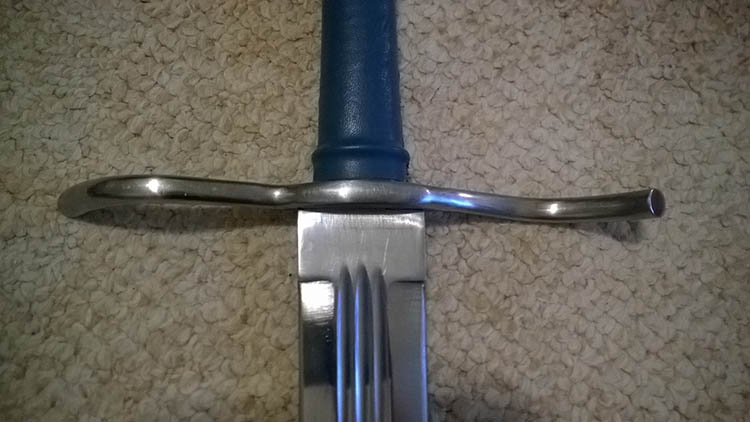
The guard is a Style 12 Type “S” Guard typically found on swords of the
15th century.
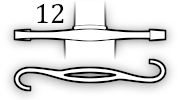
The S Style 12 guard was designed as an “S” to offer added
protection to the hand from an opponents blade as well as a more
refined tool for parrying and or trapping compared to the standard
straight or curved crossguards found on earlier period swords. They also
added some obvious flair to the sword’s appearance as that was also
becoming more popular at the time.
The S-Guard on the Mercenary
is pretty basic and lacks the finer details found on the historical
originals featuring them. It’s made of steel and has a similar
semi-gloss polish like the blade. It’s stout and strong with a rounded
shape and makes me feel confident it would succeed if meeting another
blade for it’s intended purpose. The middle of the guard widens to
almost 3/4” and feels comfortable to the top of my hand. The top is
lacking a recessed groove for the blade to enter like most guards but
has a rectangular cutout for the tang. It’s not very pretty but you get
what you pay for. Honestly at the new price point on re-intro, this is
something Hanwei should have remedied.
The Pommel
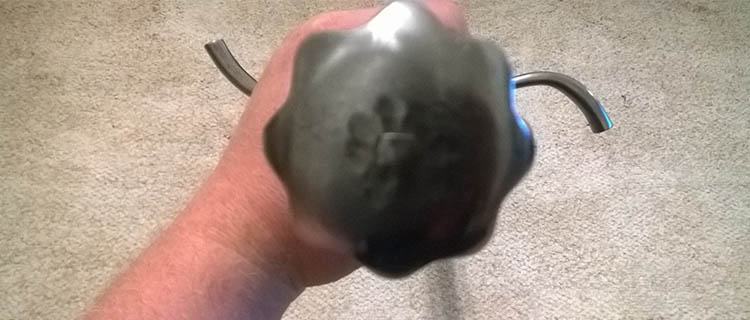
The Pommel is a Type T Style “scent stopper” pommel, which were very
popular in the 14th-16th centuries. They were large solid diamond shaped
pommels which added extra counter balance as well as a formidable
weapon when striking with the pommel. It’s literally a mini-mace on the
end of the sword hence the term “scent stopper”, or pretty much nose
breaker. Many of the 15th century variants had facets carved in to add
aesthetic value as well as ( proven in the original sword) to hold
little trinkets like holy relics or perhaps family mementos or
heirlooms.






The pommel on the Mercenary is much like the rest of the sword a simple take on the original. The shape is accurate to historical pieces but still has that basic and plain appearance. Its made of the same steel as the guard and has the same polish. The pommel itself is cast well and is solid. It has a peened construction which is definitely a bonus and adds much to the structural integrity of the sword. Overall a well made pommel that does a pretty good job of representing it’s Typology.
The Scabbard
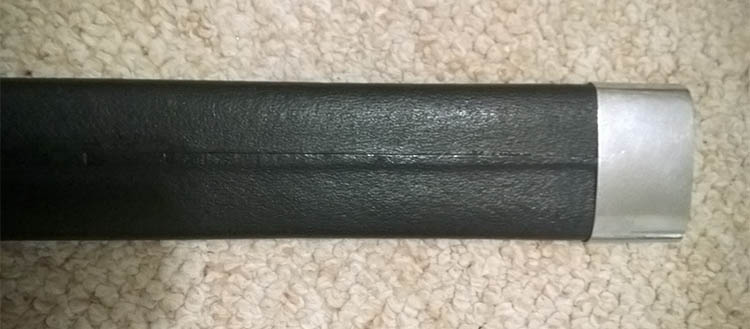
The scabbard is actually pretty impressive compared to most offerings at this sword’s price point. It’s has a wood core wrapped in leather with a steel mouth and chape with the same polish as the hilt furniture. The leather is glued at the seem and not butted but overlaps. Not very attractive but the leather is glued tight and the seem has never frayed or peeled. What’s really impressive is the fit of the scabbard to the blade. Its a little wide at the mouth so the blade shifts at the base but the rest of the blade fits snug with no rattle. Held upside down it takes a few shakes to get the blade to fall which is pretty impressive when up against such a heavy hilt. I’d chock it up to the riccasso, so ugly or not I guess it has a function after all.
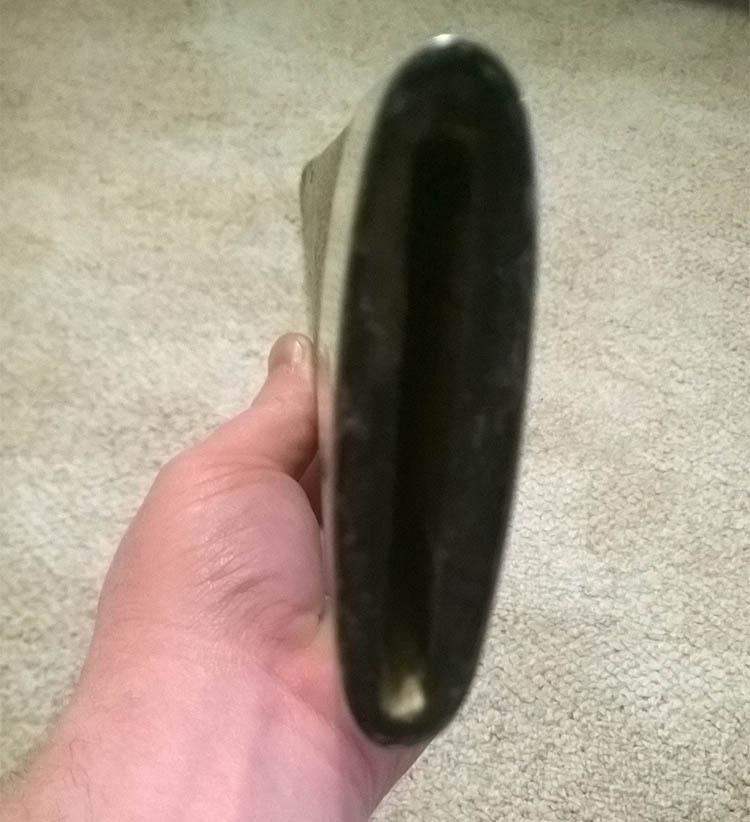
Overall for the old and new price points these scabbards were a great addition to the overall package and completely outclass the simple leather of Windlass and the blade scratching mouth, cheap, loose fitting, plastic core Hanwei Tinker scabbards. I still to this day don’t understand why Hanwei didn’t go for these simply made but better quality scabbards for the Hanwei Tinker Line. Overall a pretty decent wood core scabbard.
Handling
This sword handles like a beast yet still is more agile and controllable than other beaters of its time like the Gen 2 or DSA of the “beater heyday” (we older forumites remember those days) quite a few years back. It can be used one handed but it’s power and authority comes with the two-handed grip. It’s definitely a slasher but can also make some pretty devastating thrusts. The rigid blade doesn’t have much flex but does have a little. It’s hard to calculate if the period originals were as rigid and thick as this Hanwei model or if they had a more thinner profile. My Roven which is a Type XXa is a little more flexible but then again its of a subtype offering a more thrust oriented blade. All in all it’s definitely a two-handed sword.
Test Cutting
I’ve cut quite a bit with this sword and as I mentioned above it offers a
powerful and sturdy cut with its broad cutting surface. The tip is well
shaped and offers a strong thrusting point as well. As I mentioned
before these swords don’t come very sharp, hopefully that has been
remedied with these new models. I had to do a lot of work to get it to
my preferred sharpness even with all the work William done. Dull or
sharp though when swung full force with two hands this sword is going to
hurt. Even if you don’t cut through your target you will feel its pain
as its batted across your yard.
Meanwhile - at an undisclosed location..
David did not include a video of the sword in action - but another SBG member, Germanic - certainly did..
First slaughtering single handedly a whole army of water filled bottes..
And then dealing with some nasty looking saplings and tree trunks (which is of course, abusive destructive testing - not a good idea if you want to keep your sword in tip top condition, but a good way to test a blade to find its limits
Conclusion
Overall I’m pretty happy with my Mercenary Sword. It has a unique design based on a historical original where not many replicas or offered. It’s a beater but also a decently balanced weapon. It offers one of the longest handles I’ve seen in the production market for a Medieval Sword and is put together pretty well and build like a tank. After my modifications I feel I have a really interesting and powerful sword. Definitely a primary candidate for any late medieval infantry soldier.
Overall its a pretty decent sub-$300 sword, even if it’s original MSRP
is over $300 now. Of the four or five Hanwei Beginner (Cas Iberia)
medieval models the Mercenary is the best of the bunch with the River
Witham earning a close second. If you’re in the market for a moderately
attractive but tough as nails medieval sword or a Warsword type you
can’t go wrong with with the Mercenary. Also if you’re a katana guy
looking to get into medieval swords this sword should definitely be on
your radar for a similar handling sword.
Thanks for reading and I hope you enjoyed,
D
PROS
- Extremely durable blade and construction.
- Attractive and unique blade type with a very accurate resemblance to the historical original.
- Surprisingly well made scabbard.
CONS
- Basic in detail with a few nitpicks to the fit and finish.
- Ugly riccasso.
- The new price from Hanwei is ridiculous, even the discounted pricing on KultofAthena is ridiculous (Editors note: back in the day they were priced at around $150 and were made in the Philippines, while the current models are made at the Hanwei facility in Dailan).
WHERE TO BUY
Even though the newer versions of the Hanwei Mercenary Sword made in China are more expensive - the new price from Hanwei is $325 - the old prices of $150 are gone forever. Indeed, these days they actually cost closer to $200 wholesale - yet a couple of sellers squeeze their margins to offer the absolute best deals possible.
As mentioned in the review the best place to pick this sword up is here at Kult of Athena where it is available not for the usual retail price of $325 but over $100 less for just $232.95.
I hope this review of the Hanwei Mercenary Sword was helpful. To return to Affordable Replicas of Medieval Swords from Hanwei Mercenary Sword Review, click here














